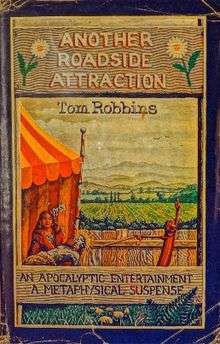Another Roadside Attraction
Another Roadside Attraction is the first novel by Tom Robbins, published in 1971.
 First edition | |
| Author | Tom Robbins |
|---|---|
| Country | United States |
| Language | English |
| Publisher | Doubleday |
Publication date | 1971 |
| Media type | Print (Hardcover & Paperback) |
| Pages | 400 pp |
| ISBN | 0-553-34948-1 |
| OCLC | 21029688 |
| 813/.54 22 | |
| LC Class | PS3568.O233 A83 2003 |
Plot
The novel follows the adventures of John Paul Ziller and his wife Amanda—lovable prophetess and promiscuous earth mother, inarguably the central protagonist—who open "Captain Kendrick's Memorial Hot Dog Wildlife Preserve," a combination hot dog stand and zoo along a highway in Skagit County, Washington. Other characters in this rather oddball novel include Mon Cul the baboon; Marx Marvelous, an educated man from the east coast; and L. Westminster "Plucky" Purcell, a former college football star and sometime dope dealer who accidentally infiltrates a group of Catholic monks working as assassins for the Vatican. In so doing Plucky discovers a secret of monumental proportions dating to the very beginning of Christianity.
Major Themes
In this novel, the author uses nonlinear plot progression in the tone of a first-person diary to express his views on religion and other topics. His humorous, scathing and insightful perceptions of those who swirl past the main characters has great comedic value. The book is a cultural icon for the "Children of the Sixties."
A major theme of the novel is the mummified corpse of Jesus Christ and Western Civilization's belief and faith in the divinity of Jesus Christ. In his memoir, Robbins states that he wanted to question what would happen to Western Civilization if it could be demonstrated that Jesus was not immortal.[1]
Development history
In 1966, Doubleday's West Coast Editor Luthor Nichols contacted Robbins to ask him to write a book on Northwest Art. Instead, Robbins told Nichols he wanted to write a novel and pitched the idea of what was to become Another Roadside Attraction.[2]
In 1967 Robbins mailed off 30 pages of his novel to Nichols who sent them on to the New York office. The senior editors, holdovers from when Doubleday was a Roman Catholic publishing house, did not approve, but Nichols encouraged Robbins to keep writing. When he had 70 pages, Nichols tried them again on New York, but the senior editors were still unconvinced. It wasn't until 1970 that Doubleday finally accepted the manuscript and in 1971 published 6,000 copies of Another Roadside Attraction.[3]
In his memoir, Robbins states that he did not want to describe the sixties in this novel but to re-create them on the page, "to mirror in style as well as content their mood, their palette, their extremes, their vibrations, their profundity, their silliness and whimsy." [4] Robbins also said he used a collage technique—he skimmed media such as the underground press, KRAB radio program guides, broadsides, fliers for concerts to try and pluck out items that might capture a portrait of the period.[5]
In the book a baboon is stolen from the Woodland Park Zoo in Seattle. Shortly after publication someone did actually steal a baboon from the Zoo.[6]
Publication history
- Robbins, Tom (1971). Another Roadside Attraction (Hardcover) (1st ed.). Doubleday. LCCN 73144292.
- Robbins, Tom (1972). Another Roadside Attraction (Paperback). Ballantine Books. ISBN 978-0-345-02770-2.
References
Notes
- Robbins 248.
- Robbins 230-32.
- Robbins 246–53
- Robbins 243–45.
- Robbins 247.
- Robbins 254.
Bibliography
- Robbins, Tom (2014). Tibetan Peach Pie: A True Account of an Imaginative Life (First ed.). HarperCollins Publishers. pp. 230–232. ISBN 9780062267405.